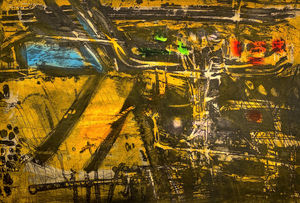
Abstraction
Mid-Century Works on Paper
Lynne Mapp Drexler (1928-1999)
Malcolm H. Myers (1917-2002)
Reginald Murray Pollack (1924-2001)
Jacob Semiatin (1915-2003)
October 2021
From Curators
Jason Howard and John Alexander:
At the end of World War II, the center of the Western Art world shifted to New York, from Paris.
As the Post-war epicenter of creativity for the avant-garde, New York gave birth to various art movements including Abstract Expressionism. Abstract art would come to dominate and influence rising artists for the next twenty years.
This exhibition pays homage to four artists who would become profoundly influenced by the ideals and aesthetics of abstract art -- and who were masters of that art form, specifically on paper.
In the 1950s…
Master printmaker, painter and educator Malcolm H. Myers (1917-2002) would find himself in New York, Paris and Mexico City on Guggenheim Fellowships -- creating, exploring and pushing the boundaries of abstracts on paper. Myers then took his experiences around the art world to the University of Minnesota where he headed the art school and founded the University's Printmaking Department (which still exists today) -- influencing generations of artists. Today he is considered one of the finest American Printmakers of the 20th century.
Abstract expressionist painter Lynne Mapp Drexler (1928-1999) found her artistic voice as a member of the New York School, being profoundly influenced by the teachings of Hans Hofmann and Robert Motherwell. Even though she had the education and talent as a painter, she was ignored by the male-centered art scene of New York. She eventually left New York in favor of a tranquil community on a remote island off the coast of Maine. Like so many artists of that period, she would abandon abstract art later in life for landscape and still life painting, spending hours in her studio almost every day. Only recently has her artwork finally been gaining the admiration of the art world.
Painter and printmaker Reginald Murray Pollack (1924-2001) was a gregarious art figure. He was present during the heyday of abstract expressionism, yet decided to shuffle his time between New York and Paris, spending more time in the latter. Throughout his many travels, he would ingratiate himself within art colonies and collectives, oftentimes becoming a central figure within those creative communities, including Galerie Huit and the Drum Lithographs (both in Paris). Pollack would eventually settle in Palm Springs, California with his muse and wife, Kerstin where he continued to create work in his signature surrealistic style.
An accomplished watercolorist, Jacob Semiatin (1915-2003) found himself in the center of the abstract expressionist movement, becoming friends with many of New York’s influential gallery owners and museum directors. Having painted cityscapes of Brooklyn and country scenes in Arkansas, he would abandon landscape painting in favor of abstract art. Even though most painters at the time were focused on large-scale paintings on canvas, Semiatin continued using watercolor as his medium. A prolific painter, he never concerned himself with showing or selling his work, provoking the ire of his friend, renowned gallerist Leo Castelli. As a result, the majority of his paintings were rarely seen and seldom sold -- yet are highly sought after today. He would marry and remain in New York continuing to paint abstract works throughout his life.







































